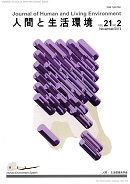Volume 21, Issue 2
Displaying 1-14 of 14 articles from this issue
- |<
- <
- 1
- >
- >|
-
Article type: Cover
2014Volume 21Issue 2 Pages Cover1-
Published: 2014
Released on J-STAGE: July 05, 2018
Download PDF (14384K) -
Article type: Appendix
2014Volume 21Issue 2 Pages App1-
Published: 2014
Released on J-STAGE: July 05, 2018
Download PDF (56K) -
Article type: Appendix
2014Volume 21Issue 2 Pages App2-
Published: 2014
Released on J-STAGE: July 05, 2018
Download PDF (56K) -
Article type: Appendix
2014Volume 21Issue 2 Pages App3-
Published: 2014
Released on J-STAGE: July 05, 2018
Download PDF (56K) -
Article type: Index
2014Volume 21Issue 2 Pages Toc1-
Published: 2014
Released on J-STAGE: January 10, 2018
Download PDF (21K) -
Article type: Index
2014Volume 21Issue 2 Pages Toc2-
Published: 2014
Released on J-STAGE: January 10, 2018
Download PDF (22K) -
Article type: Article
2014Volume 21Issue 2 Pages 67-74
Published: 2014
Released on J-STAGE: January 10, 2018
Download PDF (1103K) -
Article type: Article
2014Volume 21Issue 2 Pages 75-84
Published: 2014
Released on J-STAGE: January 10, 2018
Download PDF (1347K) -
Article type: Article
2014Volume 21Issue 2 Pages 85-91
Published: 2014
Released on J-STAGE: January 10, 2018
Download PDF (4261K) -
Article type: Article
2014Volume 21Issue 2 Pages 93-98
Published: 2014
Released on J-STAGE: January 10, 2018
Download PDF (3859K) -
Article type: Appendix
2014Volume 21Issue 2 Pages 99-
Published: 2014
Released on J-STAGE: July 05, 2018
Download PDF (69K) -
Article type: Appendix
2014Volume 21Issue 2 Pages 100-101
Published: 2014
Released on J-STAGE: July 05, 2018
Download PDF (131K) -
Article type: Appendix
2014Volume 21Issue 2 Pages App4-
Published: 2014
Released on J-STAGE: July 05, 2018
Download PDF (42K) -
Article type: Appendix
2014Volume 21Issue 2 Pages App5-
Published: 2014
Released on J-STAGE: January 10, 2018
Download PDF (42K)
- |<
- <
- 1
- >
- >|
